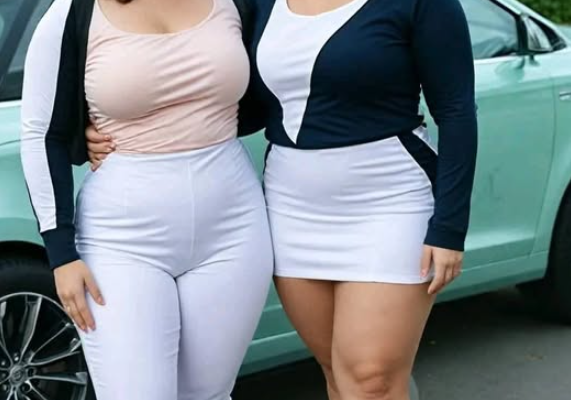Big Butts, Body Myths, and Biological Facts: What Science Really Says
Human fascination with body types — especially women’s — is nothing new. Throughout history, societies have developed all kinds of assumptions based on external appearance: body shape, height, facial features, and especially the size of a woman’s buttocks. Among the most persistent myths is the idea that a woman with a large buttocks somehow has a “certain kind” of vagina — be it in shape, size, or function. But the truth is, body shape does not determine vaginal anatomy, and the two are not directly linked in the way many people assume.
Let’s explore where these myths come from, what the human body actually tells us, and why we should be more cautious — and respectful — when making assumptions about people based on how they look.
1. The Myth: Butt Size Equals Vaginal Size
Let’s be clear: the size of a woman’s buttocks has no correlation to the size, shape, or tightness of her vagina. The vagina is an internal muscular canal, and its dimensions vary slightly among individuals — just like noses, hands, or voices — but not in any way that’s reliably predicted by outer features like hip or butt size.
This myth likely stems from a mix of sexual curiosity, cultural beauty standards, and outdated pseudoscience, where visual features were wrongly believed to indicate hidden sexual characteristics.
In reality, the appearance of a person’s butt is primarily influenced by:
-
Gluteal muscles (gluteus maximus, medius, and minimus)
-
Fat distribution, which is highly dependent on genetics and hormones
-
Pelvic bone structure, especially the width of the hips
None of these things directly affect the vagina’s function or shape.
2. Fat Distribution and Estrogen
What is true, however, is that estrogen plays a role in fat distribution in women. During puberty, estrogen influences fat to accumulate in areas like the hips, thighs, and buttocks — which is why many women naturally develop curvier figures.
These curves have evolutionary significance: they are sometimes loosely associated with fertility from a biological signaling perspective. Studies have shown that men often rate women with a waist-to-hip ratio of about 0.7 as more attractive — possibly because, across cultures, this ratio has been statistically associated with reproductive health and hormonal balance. But again, this has nothing to do with vaginal size or function.
3. The Vaginal Canal: Structure and Function
The vagina is a flexible muscular canal that typically measures between 3 to 4 inches (7.5 to 10 cm) in length at rest, but it can expand significantly during sexual arousal and childbirth. It is not a fixed-size tunnel, nor is it “loose” or “tight” based on someone’s body shape or sexual history — another common myth.
The muscles of the pelvic floor can influence vaginal tone. Women who regularly perform Kegel exercises, for example, may have more control over those muscles, which can influence sensation — but not size in the sense people often suggest.
There is no scientific link between buttocks size and vaginal tone, tightness, or depth.
4. Cultural Fixation on Curves
The modern cultural fascination with big butts — popularized in part by celebrities like Jennifer Lopez, Beyoncé, Nicki Minaj, Kim Kardashian, and others — has brought body diversity into the mainstream conversation. This is a good thing in many ways: women with fuller hips and rears are no longer pressured to conform to thin-only ideals.
However, the downside is that sexualized stereotypes about body parts — especially ones based on misinformation — persist. People may associate curves with sexual performance, libido, or genital characteristics, which is not only wrong but harmful. These assumptions reduce people to body parts and reinforce superficial judgments.
5. Where These Myths Come From
Historically, societies have made bizarre assumptions about the human body. In the 19th century, racist and colonialist pseudoscience was used to measure women’s skulls and hips to make false claims about intelligence and sexuality. Saarjite Baartman, a South African woman known as the “Hottentot Venus,” was paraded across Europe because of her large buttocks, in a degrading and dehumanizing display of racial and sexual exploitation.
Today, such overt objectification is less accepted, but subtle forms of it — like myths about body shape and sex — still linger, especially on the internet.
6. Why These Myths Are Harmful
Besides being false, these assumptions:
-
Perpetuate body shaming and unrealistic expectations
-
Objectify women, reducing them to body parts and perceived sexual utility
-
Spread misinformation that harms relationships and self-esteem
-
Reinforce gendered stereotypes that can hurt all people, regardless of identity
These myths can lead to anxiety, body dysmorphia, and even dangerous medical misunderstandings if people take them too seriously.
7. What Actually Matters in Sexual Health
Rather than focusing on outward body features, real sexual health depends on:
-
Mutual consent and communication
-
Understanding anatomy and comfort
-
Emotional connection
-
Hormonal balance and overall health
-
Respect and realistic expectations
It’s far more meaningful and satisfying to be with someone who understands and respects your body than to chase myths about physical traits that have no bearing on compatibility or intimacy.
8. Science Over Stereotypes
Science is clear: vaginal characteristics are determined by a person’s anatomy and health, not by the size of their hips or butt. Instead of clinging to myths or internet rumors, it’s better to educate ourselves with real, evidence-based knowledge.
Books, educational websites, and open conversations with medical professionals are far better sources of truth than anonymous posts and viral gossip.
9. Appreciating Body Diversity
Women come in all shapes and sizes. Some have large buttocks, some don’t. Some are curvy, some are lean. None of those characteristics say anything about how their reproductive anatomy works or how satisfying they might be as partners.
Instead of assigning meaning to curves that isn’t there, we should focus on acceptance, curiosity, and truth.
Final Thought
A woman’s body is not an equation, and it should never be reduced to one. The size of her butt does not reveal anything about her vagina, her sexual experience, or her worth. Believing otherwise isn’t just inaccurate — it’s a distraction from real connection, health, and intimacy.
Let’s move beyond the myths — and celebrate the beautiful, complex truth of human diversity.


